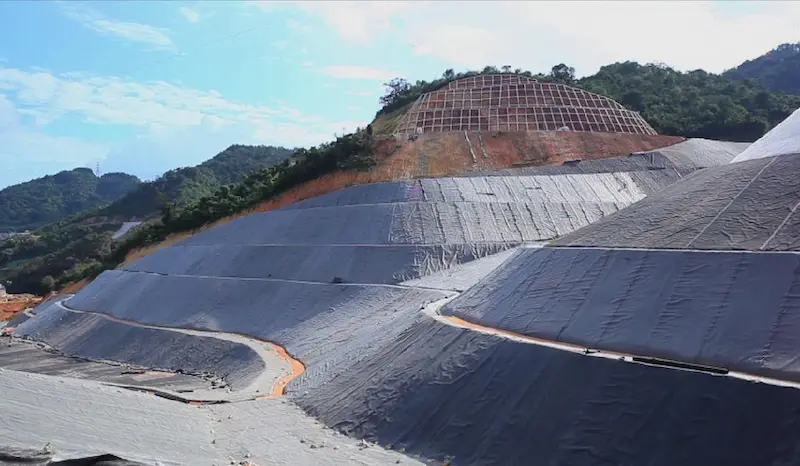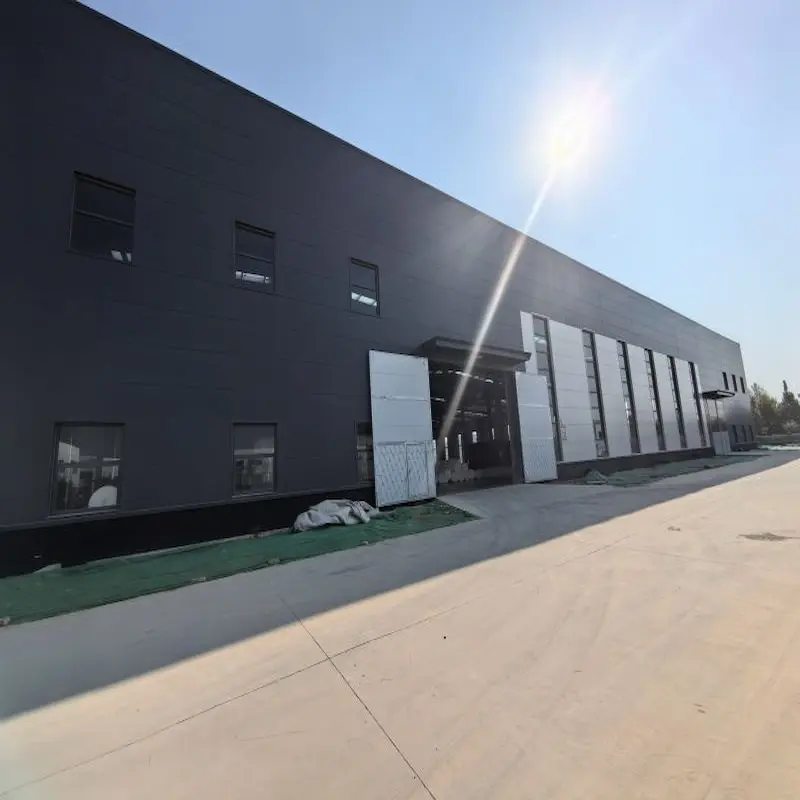What is a Geomembrane?
A geomembrane is a synthetic membrane liner or barrier used to control fluid or gas migration in a human-made structure or system. In landfill applications, geomembranes are employed to prevent leachate from contaminating the surrounding soil and groundwater. Geomembranes are highly durable, impermeable, and resistant to chemical degradation, making them a crucial component in landfill lining and capping systems.

Materials of Geomembrane for Landfill
Geomembranes are made from a variety of polymeric materials, each with specific properties suited for landfill applications. Common materials include:
Material
| Description
| Advantages
|
High-Density Polyethylene (HDPE)
| Most commonly used; strong and chemically resistant.
| High durability, UV resistance, cost-effective.
|
Linear Low-Density Polyethylene (LLDPE)
| Offers better flexibility than HDPE.
| Ideal for uneven surfaces, resistant to punctures.
|
Polyvinyl Chloride (PVC)
| Flexible material, often used for temporary applications.
| Easy to install, highly flexible.
|
Ethylene Propylene Diene Monomer (EPDM)
| Rubber-like material, used for its elasticity.
| Excellent weather resistance, flexible.
|
Specifications of Geomembranes for Landfill
Geomembranes come in various specifications tailored to different landfill applications. Below are some common specifications:
Property
| Typical Values
| Description
|
Thickness
| 0.5 mm – 3.0 mm
| Determines strength and puncture resistance.
|
Width
| Up to 8 meters
| Reduces the number of seams in large installations.
|
Tensile Strength
| 20 MPa – 40 MPa
| Indicates durability under tension.
|
Elongation at Break
| 200% – 800%
| Reflects flexibility and ability to adapt to movement.
|
Permeability
| <1 × 10⁻¹³ cm/s
| Measures the liner’s impermeability.
|
UV Resistance
| Excellent
| Ensures longevity when exposed to sunlight.
|
The specification of geomembranes for landfill applications is critical to ensuring effective containment of waste and preventing environmental contamination. These specifications typically align with industry standards and are influenced by the specific application, regulatory requirements, and site conditions.
Prices of Geomembrane for Landfill
Geomembranes are essential in landfill projects, serving as impermeable barriers to prevent contaminants from leaching into the surrounding environment. The cost of geomembranes varies based on material type, thickness, manufacturer, and project size. Below is an overview of typical costs associated with different geomembrane materials:
| Material Type
| Approximate Cost per Square Foot |
Approximate Cost per Square Foot | $0.50 – $2.00 |
Linear Low-Density Polyethylene (LLDPE) | $0.60 – $2.50 |
Polyvinyl Chloride (PVC) | $0.60 – $2.00 |
Ethylene Propylene Diene Monomer (EPDM) | $0.75 – $2.50 |
These prices are approximate and can vary based on market conditions and specific project requirements.
For instance, HDPE geomembranes are commonly used in landfill projects due to their durability and chemical resistance. The cost for HDPE geomembranes typically ranges from $0.50 to $2.00 per square foot, depending on factors such as thickness and manufacturer.
Standards of Geomembrane for Landfill
The standard of geomembranes for landfill applications is governed by various international and national guidelines that ensure the material's quality, performance, and suitability for environmental protection. Below are the key standards and specifications commonly used for geomembranes in landfill applications:
ASTM International Standards
ASTM D5994: Standard Test Method for Measuring the Thickness of Geomembranes.
ASTM D6693: Test Method for Determining Tensile Properties of Geomembranes.
ASTM D5199: Standard Test Method for Measuring the Nominal Thickness of Geotextiles and Geomembranes.
ASTM D5322: Standard Practice for Immersion Procedures for Evaluating the Chemical Resistance of Geosynthetics.
ASTM D5747: Test Method for Evaluating Chemical Resistance of Geomembranes to Liquids.
ASTM D4833: Standard Test Method for Puncture Resistance of Geomembranes.
ASTM D4355: Standard Test Method for Deterioration of Geotextiles from Exposure to Ultraviolet Light and Water.
ISO Standards
ISO 1183: Plastics—Methods for Determining Density.
ISO 12956: Test Method for Determining the Characteristic Opening Size of Geotextiles and Geomembranes.
ISO 25780: Geosynthetics—Methods for Exposure to UV Radiation, Elevated Temperature, and Water.
Geosynthetic Research Institute (GRI) Standards
GRI-GM13: Specification for HDPE Smooth and Textured Geomembranes.
Minimum thickness: 1.0 mm (40 mil) for textured, 1.5 mm (60 mil) for smooth.
Tensile properties, elongation, and stress crack resistance.
UV resistance with a requirement of 2%–3% carbon black.
GRI-GM17: Specification for LLDPE Smooth and Textured Geomembranes.
Similar requirements to GRI-GM13 but tailored for LLDPE.
Applications of Geomembrane for Landfill
1. Bottom Liners
Geomembranes are extensively used as bottom liners in landfills to:
Prevent Contaminant Migration: Act as a barrier to leachate (liquid produced from waste decomposition) to prevent it from contaminating groundwater.
Enhance Durability: Protect the underlying soil and geotechnical systems from chemical and biological degradation.
Common Materials: High-Density Polyethylene (HDPE) and Linear Low-Density Polyethylene (LLDPE) due to their excellent chemical resistance and mechanical strength.
2. Capping Systems
When a landfill reaches its capacity, geomembranes are used as part of the capping system to:
Minimize Water Infiltration: Reduce rainwater penetration, preventing leachate formation.
Contain Gas Emissions: Trap gases like methane for collection and treatment.
Support Vegetation: Serve as a stable layer for soil and vegetation to grow.
Common Materials: HDPE and Polyvinyl Chloride (PVC) are often chosen for capping due to their flexibility and UV resistance.
3. Leachate Collection Systems
Geomembranes are a crucial component of leachate collection and management systems:
Channeling Leachate: Line channels and sumps to direct leachate to treatment facilities.
Preventing Leakage: Ensure the safe containment of leachate during transport and treatment.
Common Materials: HDPE geomembranes, owing to their impermeability and chemical compatibility with leachate.
4. Gas Collection and Management
Landfill gases like methane and carbon dioxide are by-products of waste decomposition. Geomembranes aid in:
Gas Capture: Serve as barriers to prevent gas escape.
Energy Recovery: Support systems for methane collection and its conversion into renewable energy.
Common Materials: Flexible geomembranes like LLDPE are ideal for adapting to settlement and movement in landfill layers.
5. Secondary Containment
Geomembranes provide additional containment layers in areas where the risk of contamination is high:
Double-Lining Systems: Used in conjunction with clay liners or geosynthetic clay liners (GCL) for enhanced protection.
Redundancy in Design: Provide backup containment in case of primary liner failure.
Common Materials: HDPE geomembranes due to their robust properties.
6. Stormwater Management
Stormwater control systems in landfills often utilize geomembranes to:
Prevent Erosion: Stabilize slopes and prevent erosion caused by rain.
Direct Runoff: Line channels and ponds to direct stormwater away from waste cells.
Common Materials: PVC and HDPE geomembranes, selected for their adaptability and durability.
Key Advantages of Geomembranes for Landfill

1. Effective Containment
Low Permeability: Geomembranes act as an impermeable barrier, preventing the leakage of leachate into the surrounding soil and groundwater.
Gas Control: Prevents the escape of harmful landfill gases such as methane and allows for controlled gas collection.
2. Chemical Resistance
Durability Against Chemicals: Geomembranes, particularly HDPE, are highly resistant to a wide range of chemicals, including acids, bases, and hydrocarbons, which are commonly found in landfill leachate.
Longevity: Chemically resistant materials ensure long-term performance even in aggressive environments.
3. Environmental Protection
Groundwater Protection: Protects aquifers and water resources from contamination by landfill leachates.
Soil Conservation: Prevents the migration of contaminants into surrounding soil, preserving land quality.
Tips for Selecting a Geomembrane for Landfills
1.Assess Project Requirements: Consider the type of waste, environmental conditions, and expected lifespan.
2.Choose the Right Material: HDPE is ideal for most applications, but LLDPE or PVC may be better for specific conditions.
3.Ensure Compliance with Standards: Verify the material meets ASTM, ISO, or local regulatory requirements.
4.Consult Experts: Work with a qualified supplier or installer to ensure optimal performance.
Conclusion
Geomembranes are indispensable in modern landfill systems, offering unparalleled protection against environmental contamination. By understanding their materials, specifications, standards, and applications, stakeholders can make informed decisions to ensure long-term safety and efficiency. Whether it’s a municipal or hazardous waste landfill, investing in high-quality geomembranes is a step toward sustainable waste management.

897.webp)
942.webp)
237.webp)